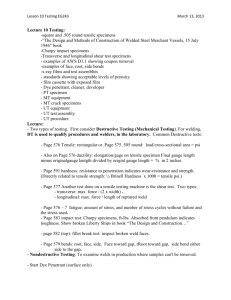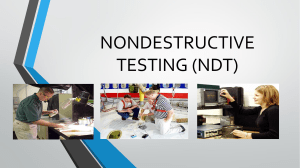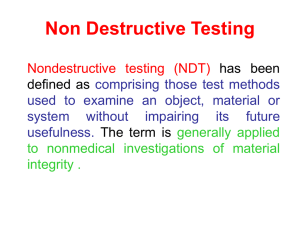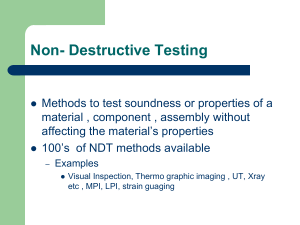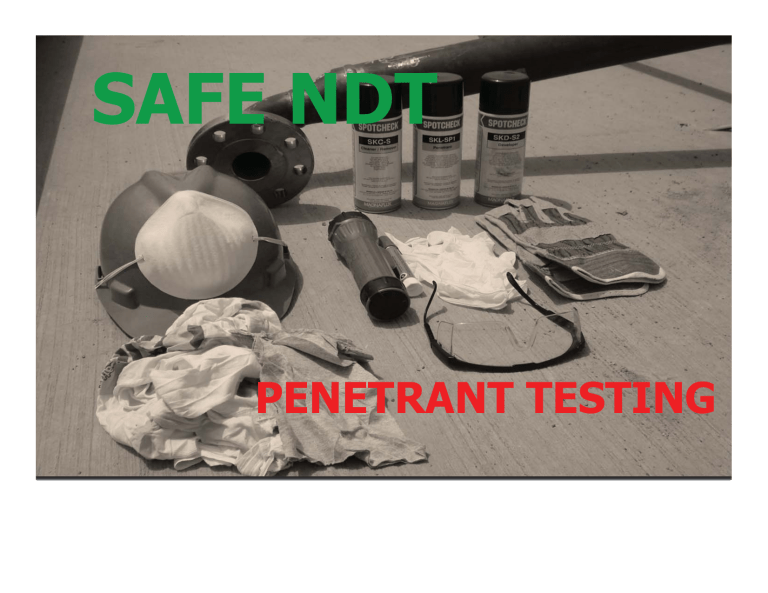
SAFE NDT PENETRANT TESTING INTRODUCTION ¾ Non-Destructive Testing (NDT) plays a vital role in assuring Safety, Integrity & Reliability of a process plant. ¾ Advancement in this field is rapid with new techniques emerging every day. More concentration is give on the accuracy of the results and on the skill of technician, but at the same time one should not neglect the safety of the technicians who perform the test and the hazards involved. ¾ Though the hazard levels are within limits, sometimes the tests are carried out without providing enough attention for personnel safety. ¾ Out of four common NDT methods much attention is given for RT safety and least attention is given to all other three methods. Even most of the technicians are not aware of the MSDS and its contents. ¾ This paper presentation will discuss in detail the precaution measures that has to be taken while carrying out Non Destructive Testing particularly in Dye Penetrant Testing and also a typical case study is briefed. PT & TECHNICIAN ¾ Penetrant Testing is a cost effective nondestructive method for determining cracks, porosity, gouges, laps, seams, and other flaws that are open to the surface. ¾ As such penetrant method is simple in principle but requires extra care while using the chemicals (Penetrant, Developer & Cleaner). Here we will discuss the safe use of penetrant while carrying out Non Destructive Testing (Starting from purchase to disposal). TECHNICIAN ¾ A penetrant inspector must be physically qualified to perform penetrant Inspection reliably. The physical health of penetrant inspection personnel should not be altered by performance of penetrant inspection operations. To ensure health and freedom from accidents or injury, NDT personnel should be aware of job-related hazards and safety precautions. IMPORTANCE OF PT SAFETY ¾ In our experience we come across one situation where minor fire incident has happened while carrying out penetrant testing in a heater bend. ¾ The bend was projected outside of the heater box and the NDT technician got permit to check the edges of the bend. ¾ In the mean time post weld heat treatment of one of the heater tube coil was also going on inside the heater that the technician was not aware. ¾ When the technician applied cleaner, immediately a flash of fire occurred. In this flash the technician escaped with very minor injury. ¾ Normally for penetrant testing most of us think that there is no risk involved but the above incident is an eye opener which insists the importance of safety during penetrant testing. PURCHASE OF PENETRANT MATERIALS ¾ Safety in penetrant testing starts as early as from its purchase. The penetrant material should be purchased from a standard manufacturer and it should have Material Safety Data Sheet (MSDS). The technicians should aware of the MSDS and safe handling of penetrant materials. All three chemicals, penetrant, developer and cleaner should be purchased from the same manufacturer and stored properly. All three chemicals from same manufacturer QUALITY CONTROL OF LIQUID PENETRANT MATERIALS ¾ Quality control of incoming penetrant processing materials, as well as quality control of in-use inspection materials on a periodic basis, is essential for a reliable penetrant inspection program. ¾ If incoming processing material is contaminated or has been improperly manufactured, validity of the entire penetrant inspection process can be substantially impaired. While the seriousness of such an occurrence might be of more concern in some plants than others. ¾ Inspection carried on while improper test techniques or substandard penetrant inspection materials were in use could result in uncontrolled variations in penetrant system performance. Such variability would render penetrant inspection unreliable and non reproducible. STORAGE OF PENETRANT MATERIALS ¾ Materials packaged in aerosol spray containers are not affected by normal storage conditions but hot and cold storage conditions can affect penetrant test materials adversely. ¾ Cold storage will cause freezing of many liquid penetrant materials. Freezing will not usually prevent the penetrant test material from performing normally after warming to the temperature of use, but in a few cases, freezing of penetrant test materials has caused irreversible separation of constituents and performance failure. ¾ Hot storage for limited periods of time usually has little effect however; hot storage for long periods of time (months or years) can cause internal chemical reaction between the components of certain materials, with subsequent loss in performance. ¾ High storage temperatures raise the pressure, and extremely high pressures can cause bursting of the aerosol can. Therefore, aerosol can temperature should never exceed 55°C (130°F). DETERIORATION OF PENETRANT MATERIALS ¾ Expendable materials used in penetrant inspection are relatively stable, but still are subject to deterioration and contamination, which can affect their performance. Performance can change in both the plus direction of increased inspection sensitivity and in the minus direction of reduced inspection sensitivity. Either direction of change could be a problem. ¾ Deterioration is largely the result of time and storage conditions. Aerosol packages do not have infinite shelf life, largely because there is always some slight leakage of propellant through the valve. This leakage normally does not cause a significant change of spray performance until at least 2 years after the date of manufacture, but eventually there will be a loss. Some cans may be completely depressurized after storage for 3 to 5 years. HAZARDOUS PROPERTIES OF PENETRANT AND PROCESS MATERIALS ¾ Hazardous properties that must always be considered when choosing or designing any system are liquid flash point and toxicity. While these properties are not necessarily connected with the performance of the penetrant in indicating discontinuities, they are vitally important from the standpoint of safety of the users and the premises on which penetrant materials are used. The flash point and toxicity are equally important with all penetrant processing materials such as cleaners, solvents, emulsifiers, and developers. COMPOSITION/INFORMATION OF INGREDIENTS ¾ Penetrant may contain a blend of aromatic and aliphatic hydrocarbon solvent(s), refined mineral oil(s), dye, surface active agent(s), alcohol(s) and hydrocarbon propellant(s). The ingredients of developer may include 2-propanol, 2-propanone, isobutane, and talc. FLASH POINT OF PENETRANT PROCESS MATERIALS ¾ The temperature at which the vapor-air mixture first ignites is the flash point. ¾ Some of the materials intended for use in small portable kits may have considerably lower flash points, possibly as low as 5 °C (40 °F). When used with the precautions and in the manner prescribed by their manufacturers and in work areas with assured good ventilation, these materials can be used safely. ¾ However, it should always be borne in mind that spray application of flammable liquids reduces the product to the form of a fine mist composed of minute droplets. In this form, atmospheric contamination becomes more acute and the flammability hazard is increased. ¾ In united States, OSHA regulations established the minimum flash point as 93°C for flammable liquids in large open tanks, used without special precautions. TOXICITY OF LIQUID PENETRANT MATERIALS ¾ Most or all penetrants and associated materials available on the market are not actually poisonous and present no particular hazard in normal use. At the same time, there are certain precautionary measures that should be observed. ¾ Practically all liquid materials used in penetrant inspection, including penetrant, cleaner, and developers, have very good wetting detergent properties. Most of them exhibit excellent solvent power for fats and oils. If these materials are allowed to remain in contact with body surfaces for extended periods, the natural oils will be dissolved form the skin, causing it to become rough and red and eventually to crack. In this condition, secondary infection can take place, causing severe irritation or dermatitis. It can also irritate eyes, but does not damage eye tissue. Inhalation of this chemical may causes dizziness and nausea. The penetrant material is flammable hence it should not be sprayed on flame or any incandescent material. A summary of hazardous ingredients and chemicals used in Penetrant Testing are tabled below; POTENTIAL HEALTH RISK HAZARDOUS INGREDIENTS Solvent based cleaner or remover xPetroleum Distillates xlight aliphatic solvent naphtha xcarbon dioxide propellant Penetrant xPetroleum Distillates xliquefied petroleum gasses Developer xPropan-2-ol & Acetone x2-propanone xIsobutene xTalc x x x x x x x x x x flash fire mist or vapor may irritate the respiratory tract eye and skin irritation in case of liquid contact Central nervous system (CNS) depression and target organ effects if overexposed. slipping hazard if spilled the skin and eyes burn vigorously if engulfed in fire extremely flammable fast evaporating vapors can reach hazardous levels quickly in unventilated spaces irritate skin by removing natural skin oils on long or repeated exposures irritate eyes, but does not damage eye tissue dizziness and nausea if inhaled EFFECTS OF FAILURE OF SHIELDING OF BLACK LIGHTS ¾ Proper operation of the black light unit used in fluorescent penetrant inspection is essential for a good inspection and for operator comfort and efficiency. ¾ If a black light unit becomes damaged, radiation with ultraviolet wavelengths shorter than 310nm (3100 Å) may escape from its protective enclosures or filters. ¾ Operator exposure to this short wavelength radiation may cause a condition known as photokeratitis followed by conjunctivitis, which is similar to snow blindness. ¾ Symptoms may progress form a feeling of “sand” in the eyes, allergy to light, tear formation, and temporary blindness. These symptoms usually begin 6 to 12 hr after exposure and last for 6 to 24 hr, with all symptoms disappearing in 48 hr. There is no known cumulative effect. It is essential that the black light unit should not be used unless the proper filter is in place. OPERATOR EYE FATIGUE DURING BLACK LIGHT INSPECTION ¾ Many objects and materials fluoresce under black light. The teeth and fingernails fluoresce with a bluish white light. ¾ Dyes in clothing may fluoresce brightly and not always the same color as that observed under white light. Laundering agents, starches, and softeners may fluoresce brightly. ¾ These conditions add to eye fatigue and may reduce the reliability of the inspection. ¾ Eye fatigue due to extraneous light sources may be reduced by clothing selected to provide minimum background fluorescence. HEALTH AND ALLERGY SAFETY OF PENETRANT MATERIALS ¾ Penetrant inspection materials are carefully screened for potential health hazards and are qualified as safe for use by humans in an industrial operation. When used in accordance with the manufacturer’s instructions, no general health hazard should be encountered. ¾ Humans vary in individual nature and may react differently to the penetrant materials, usually in the form of allergic reactions. Allergies usually manifest themselves as a form of dermatitis on the hands or arms. ¾ Other forms of allergic reaction are more subtle and need to be evaluated by competent medical personnel. If allergies persist, the operator may be unable to perform penetrant inspection routinely. Continued… ¾ Another condition suffered by penetrant processors is “dish-pan hands” or chapped hands. This condition usually arises from removing natural oil from the hands by the solvent action of penetrant processing liquids. It may be prevented by wearing rubber gloves and/or by daily application of medicated protective skin creams. ¾ General personnel safety and alertness must be practiced whenever vapors and solvents are used in an operation. ¾ Prolonged breathing of penetrant vapors, emulsifier vapors, or solvent removers may cause headaches, nausea, and/or tightness or pain in the chest. ¾ To avoid this problem, forced air ventilation exhausting to the outside of the building may be required in addition to constant alertness to breakdown of the system and/or increased sensitivity of personnel. SAFETY CONSIDERATION FOR PENETRANTS ¾ Penetrant testing is relatively free from invisible or uncontrolled personnel hazards, but reasonable precautions are desirable for operator comfort. Penetrants will often cause skin irritation for some people if the skin is continually exposed to the penetrant liquid. This is due to the removal of natural skin oils by the oil or solvent base of the penetrant. Applying Penetrant by wearing proper gloves PRECAUTIONS The following procedures are suggested as precautions for reducing skin irritation by the penetrant: ¾ Avoid contact of penetrant with skin by handling test parts in baskets or by wearing neoprene gloves. ¾ Keep interior of gloves clean ¾ Keep penetrant away from clothes ¾ Wash any penetrant from skin with soap and water as soon as possible ¾ Check periodically for traces of fluorescent penetrant on skin, clothes and inside of gloves by examining under black light. SAFETY CONSIDERATION FOR DEVELOPERS ¾ Developers should be applied in a well-ventilated area or within a hood equipped with an exhaust system to reduce inhalation hazard. ¾ Use of the nonaqueous wet developer also involves some hazards because of inhalation of the solvent carriers in which the developer particles are suspended. Applying Developer by wearing proper gloves SAFETY CONSIDERATION FOR SOLVENT REMOVERS ¾ Solvent remover poses fire and health hazards hence do not use flammable solvents near ignition sources. Use volatile solvents only with ventilation that is adequate to carry solvent vapors away from closed areas. Before repair by welding make certain that all volatile material of solvent has evaporated from test part. ¾ ¾ Within closed tanks, all personnel should be provided with adequate ventilation or with equipment to supply breathing air. Applying cleaner by wearing proper gloves TESTING IN CONFINED SPACE ¾ At most care should be taken while performing the test inside the confined space environment. ¾ Proper permit should be taken prior to entering and the personnel should be medically fit for working inside confined space. ¾ The confined space atmosphere should be properly ventilated, the technician and assistant should wear all personnel protective equipment and online respiratory mask. ¾ At a time only one activity is allowed inside the confined space and an attendant should be stationed outside the manway and proper sign board should be provided at all time. EXPOSURE CONTROLS/PERSONAL PROTECTION Engineering Measures - Provide adequate ventilation. Where reasonably practicable, this should be achieved by the use of local exhaust ventilation and good general extraction. If extraction methods are insufficient to maintain concentrations of particulates and/or solvent vapors, suitable respiratory protective equipment should be worn. PT materials with proper PPE EXPOSURE CONTROLS/PERSONAL PROTECTION General Protection - All Personal Protective Equipment (PPE), including Respiratory Protective Equipment (RPE), used to control exposure to hazardous substances must be selected to meet the requirements. Hand Protection - Full physical protection is best. Barrier cream may be of help but should not be applied after exposure has occurred. Eye Protection - Eye protection designed to protect against liquid splashes should be worn. Skin Protection - Cotton or cotton/synthetic overalls or coveralls are normally suitable. Grossly contaminated clothing should be removed and the skin should be washed with soap and water. FIRST AID MEASURES ¾ Remove the person to fresh air, keep warm and at rest. ¾ If breathing is irregular or stopped, give artificial respiration. ¾ If exposed to eyes, wash with clean, fresh water for at least ten minutes holding the eyelids apart – seek medical advice. ¾ If exposed to skin, wash skin thoroughly with soap and water or use a proprietary skin cleaner, Do NOT use solvents or thinners. ¾ If accidentally swallowed, obtain immediate medical attention. ¾ In all cases of doubt or when symptoms persist, seek medical attention. Never give anything by mouth to an unconscious person. FIRE FIGHTING MEASURES Fire will produce dense black smoke containing hazardous products of combustion. Decomposition products may be hazardous to health. Appropriate self-contained breathing apparatus may be required. Exclude sources of ignition and ventilate the area. Exclude non-essential personnel. Avoid breathing vapours. Extinguishing Media - Carbon Hydrocarbons, Sand, Foam. dioxide, Dry powder, Halogenated DISPOSAL CONSIDERATIONS The MSDS & manufacturer recommendation has to be followed while disposing the penetrant wastes. In our refinery the empty cans & waste clothes of penetrant testing are disposed in accordance with Solid Waste Management Procedure of KNPC. CONCLUSIONS AND RECOMMENDATIONS ¾ Since penetrant testing is simple, in general most of the NDT operators are not giving enough attention to personal safety and health. Although they have read the warning messages on the packages, they did not heed them. ¾ The employers should be responsible for providing a safe working environment, safety guide and protective equipment, etc. Recommendations of using chemical should also be given. ¾ When applying chemicals from aerosol cans, all inspectors must take very great care to protect not only their own well-being, but also that of their colleagues around them who may or may not be involved in the inspection task. ¾ Furthermore, great care must be taken in handling and storage of the chemicals to avoid fire and explosive hazards. By proper planning and following necessary safety precaution, penetrant testing can be carried out in a safe manner. THANK YOU.
